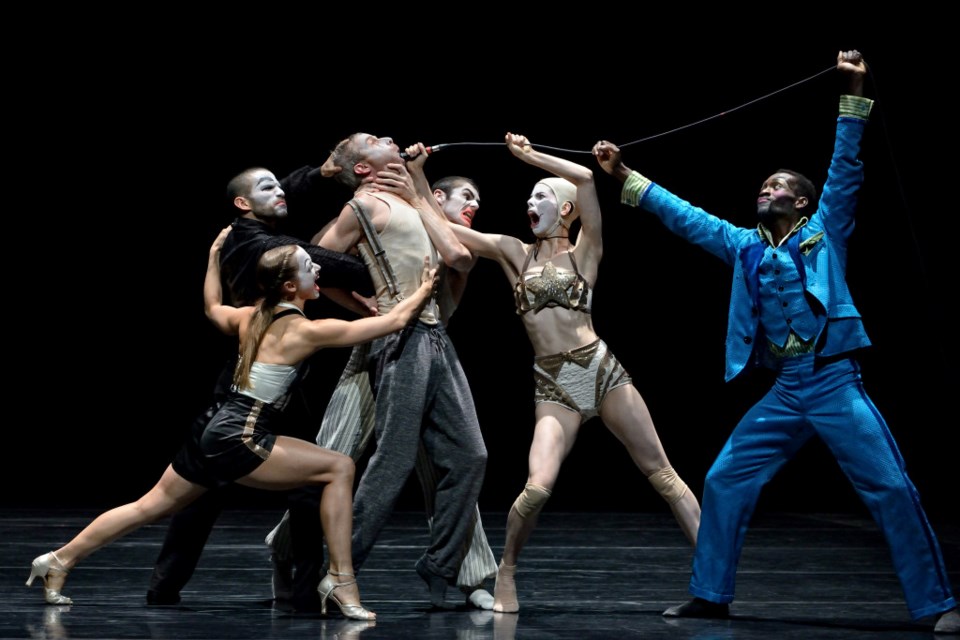In a letter to a friend, Edgar Allan Poe once confessed, “I have absolutely no pleasure in the stimulants in which I sometimes so madly indulge.”
Such is the predicament at the centre of Betroffenheit, the story of a man trapped by his memories, with no option but to indulge in a wild and dangerous dance with addiction to escape his personal pain.
Directed and choreographed by Crystal Pite of Kidd Pivot (Dark Matters, The Tempest Replica), and written and performed by Electric Company Theatre innovator Jonathon Young, Betroffenheit is not only a timeless portrait of grief and loss, but an unforgettable union of dance and theatre that achieves more than what either would be able to on their own.
The show opens with The User (Young) sitting in a chillingly stark room, flanked by snaking cables, institutional grime, and two ominous exits. Suddenly, an obscure self-help mantra starts booming out of the speakers as lights flash and The User begins to pace frantically back and forth.
The voice is The User’s own and, despite his distress, he holds what appears to be a very familiar conversation with himself. You realize that The User is comfortable here. He knows the routine, and you’re left filling in the blanks – what happened to this man? What ails him? And is the voice benevolent, or a product of The User’s own disease?
It soon becomes clear that it’s both. The User’s voice is in some cases the calm voice of reason and emotional control, and in others – like when it eerily appears to be emanating from dancer Jermaine Spivey’s mouth – the devil on his shoulder that welcomes the suggestion of a self-medicated time-out.
As the show builds momentum, gloriously costumed dancers, each representing a fragment of The User’s broken subconscious, skulk in and out of the room to taunt him and perhaps further illustrate the fact that, while they are free to come and go, he cannot escape. Cut off from all outside contact except one tearful (imagined?) phone call with his mom, he is existentially caught between trying to come to terms with an unspecified horror via “The System”, while all the more drawn to his urge to lose control and block it out with “The Show”.
Eventually, The System fails. He gives in to his need for relief and The Show – a Brazil-esque cabaret of salsa, tap, magic and pizzazz – overwhelms our star. The User’s worries instantly melt away and he cavorts euphorically with his corps de demons, even as The Show – standing in for drugs, drink or whatever poison – threatens to kill him.
Betroffenheit, a German word that loosely translates to mean the shock or impact of a particular event, represents the place where one becomes sharply aware of the limits of human response. Based on a deeply personal trauma that Young’s family suffered in 2009 when his teenaged daughter and her two cousins perished in a cabin fire, watching him try to beat back the memory on stage as The User presents as a harrowing fait accompli. You know The User won’t find his epiphany in The Show. He knows it, too. The accident happened. It is always happening. There is nothing else down there.
As personal as this performance is, however, Young and Pite masterfully strip the story down to abstraction, demonstrating the inputs and outputs of addiction and grief through mind-blowing choreography and clever staging instead. Every movement, every gasp-inducing surprise serves to reinforce the fact that The Show is always there, waiting, and the only safe response is for The User to not respond.
The first act of the two-hour show is a theatrical circus, a spectacle of such gut-wrenching perfection that you sometimes can’t quite believe what you’re seeing. Tiffany Tregarthen’s co-dependent hunchback threatens to consume The User simply through the contortions of her legs; David Raymond’s bowler-sporting, ill-intentioned tap dancer summons the very essence of death with his swinging feet; and, as The User’s competitive, charismatic split personality, Spivey is self-loathing personified.
As effective as they are, though, Pite opts to take the constraints – the lighting, the set, the flashy costumes, the narrative – away in the second act in favour of pure dance. Playing out in the empty black stage, this gesture actually makes struggle even clearer. The destructive influences and ideas from the first act are repeated and expounded on, but, in the dark, they are more vulnerable, more raw, and more likely to be seen for what they are and overcome.
In fact, there is a moment near the end, where Young faces Spivey in the belly of rock bottom, and you hope that maybe, just maybe, he can escape it alone.
• Betroffenheit, a Kidd Pivot and Electric Company Theatre production, was presented by DanceHouse at the Vancouver Playhouse Feb. 25-27.


